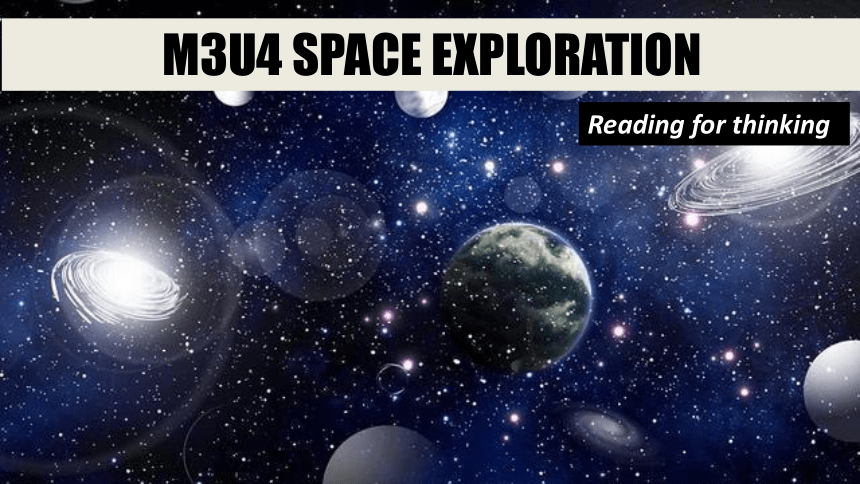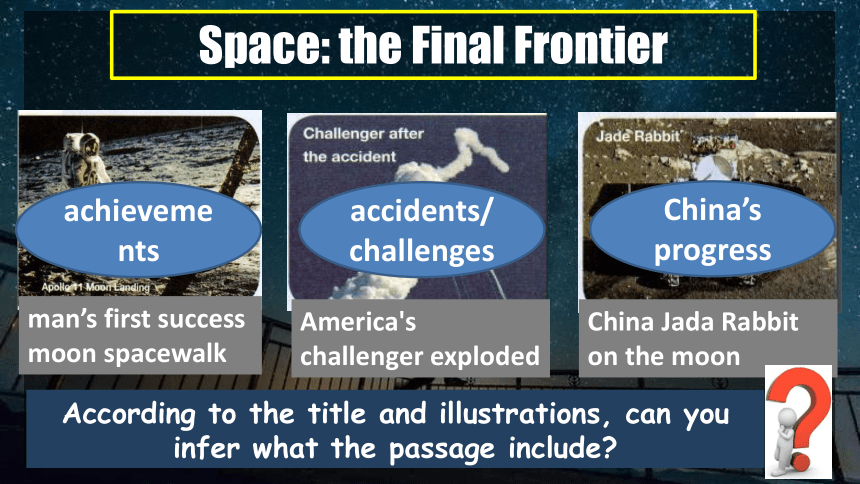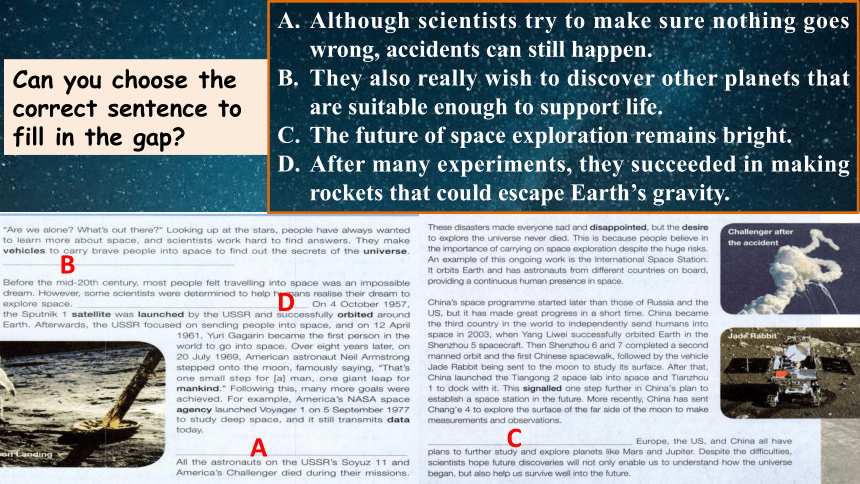Unit4 Space Exploration ReadingandThinking(共30张ppt)
文档属性
| 名称 | Unit4 Space Exploration ReadingandThinking(共30张ppt) |  | |
| 格式 | zip | ||
| 文件大小 | 5.0MB | ||
| 资源类型 | 教案 | ||
| 版本资源 | 人教版(2019) | ||
| 科目 | 英语 | ||
| 更新时间 | 2022-01-13 17:28:10 | ||
图片预览












文档简介
(共30张PPT)
M3U4 SPACE EXPLORATION
Reading for thinking
Mystery created wonder and wonder is the basis of man’s desire to understand.
-- Neil Armstrong
Yuri Gagarin,
the Soviet Union
the first man to travel into space in 1961
the first person to walk on the moon in 1969
Neil Armstrong,
the US
astronaut
pioneer
When you are looking up at the stars/universe, are you curious about the unknown universe Are you feel lonely and down
Space: the Final Frontier
Space: the Final Frontier
Space, the final frontier. These are the voyages of the starship Enterprise. Its continuing mission, to explore strange new worlds, to seek out new life and civilizations, to boldly go where no man had gone before.
Space: the Final Frontier
man’s first success moon spacewalk
America's challenger exploded
China Jada Rabbit on the moon
According to the title and illustrations, can you infer what the passage include
achievements
accidents/challenges
China’s progress
Although scientists try to make sure nothing goes wrong, accidents can still happen.
They also really wish to discover other planets that are suitable enough to support life.
The future of space exploration remains bright.
After many experiments, they succeeded in making rockets that could escape Earth’s gravity.
Can you choose the correct sentence to fill in the gap
C
D
B
A
“Are we alone What’s out there ” Looking up at the stars, people have always wanted to learn more about space, and scientists work hard to find answers. They make vehicles to carry brave people into space to find out the secrets of the universe. They also really wish to discover other planets that are suitable enough to support life.
Para. 1
Why do people want to explore space
discover other planets that are suitable enough to support life.
find out the secrets of the universe
learn more about space
main idea:
Humans have always had _______________
about space.
a natural curiosity
Space exploration carries human’s curiosity.
“Are we alone What’s out there ” Looking up at the stars, people have always wanted to learn more about space, and scientists work hard to find answers. They make vehicles to carry brave people into space to find out the secrets of the universe. They also really wish to discover other planets that are suitable enough to support life.
Para. 1
Why does the passage begin with two questions
To impress readers
To attract readers’ attention and curiosity about the content
To raise readers’ reflection
Before the mid-20th century, most people felt travelling into space was an impossible dream. However, some scientists were determined to help humans realise their dream to explore space. After many experiments, they succeeded in making rockets that could escape Earth’s gravity. On 4 October 1957, the Sputnik 1 satellite was lunched by the USSR and successfully orbited around Earth. Afterwards, the USSR focused on sending people into space, and on 12 April 1961, Yuri Gagarin became the first person in the world to go into space. Over eight years later, on 20 July 1969, American astronaut Neil Armstrong stepped onto the moon, famously saying, “That’s one small step for [a] man, one giant leap for mankind.” Following this, many more goals were achieved. For example, America’s NASA space agency launched Voyager 1 on 5 September 1977 to study deep space, and it still transmits data today.
Para. 2
What’s the topic sentence in Para. 2
However, some scientists were determined to help
humans realise their dream to explore space.
How realised their dream
before the mid-20th century
4 Oct. 1957
12 Apr. 1961
20 Jul. 1969
5 Sep. 1977
an impossible dream
The Sputnik 1 satellite was launched bt the USSR
Yuri Gagarin, he first person to go into space
Neil Armstrong stepped onto the moon
Voyager 1 was sent to study deep space, and transmits data today
a reality
determination
persistence
curiosity
effort
ambition
That’s one small step for a man, a giant leap for mankind.
Space exploration motivates human’s determination, persistence, curiosity, effort and ambition.
Para. 2
impossible dream
before the mid-20th century
4 Oct. 1957
12 Apr. 1961
20 Jul. 1969
5 Sep. 1977
The Sputnik 1 satellite was launched bt the USSR
Yuri Gagarin, he first person to go into space
Neil Armstrong stepped onto the moon
Voyager 1 was sent to study deep space, and transmits data today
The USA
The USSR
VS
Why was space exploration mainly carried out by the USSR and the US in the 20th century
the Cold War
competition between two superpowers
Further thinking:
Before the mid-20th century, most people felt travelling into space was an impossible dream. However, some scientists were determined to help humans realise their dream to explore space. After many experiments, they succeeded in making rockets that could escape Earth’s gravity. On 4 October 1957, the Sputnik 1 satellite was lunched by the USSR and successfully orbited around Earth. Afterwards, the USSR focused on sending people into space, and on 12 April 1961, Yuri Gagarin became the first person in the world to go into space. Over eight years later, on 20 July 1969, American astronaut Neil Armstrong stepped onto the moon, famously saying, “That’s one small step for [a] man, one giant leap for mankind.” Following this, many more goals were achieved. For example, America’s NASA space agency launched Voyager 1 on 5 September 1977 to study deep space, and it still transmits data today.
Para. 2
What’s the topic sentence in Para. 2
However, some scientists were determined to help
humans realise their dream to explore space.
How does the writer show the achievements in space exploration
using examples C. giving specific number
making comparison D. giving definition
Writing tip 1 : Examples and specific numbers can make a scientific article more pervasive and objective.
What are benefits of using examples and specific numbers
To be more detailed, vivid and persuasive
To impress readers with great progress in space exploration
To make it more easy-understanding
before the mid-20th century
4 Oct. 1957
12 Apr. 1961
20 Jul. 1969
5 Sep. 1977
The Sputnik 1 satellite was launched bt the USSR
Yuri Gagarin, he first person to go into space
Neil Armstrong stepped onto the moon
Voyager 1 was sent to study deep space, and transmits data today
However, some scientists were determined to help humans realise their dream to explore space.
main idea:
Space travel became __________ in the 20th century with ________ and ________________ remarkable mission.
the Soviet Union
American
a reality
Space exploration is always successful and satisfying
Do humans stop exploring space due to problems or failures
Why don’t humans stop
Although scientists try to make sure nothing goes wrong, accidents can still happen. All the astronauts on the USSR’s Soyuz 11 and America’s Challenger died during their missions. These disasters made everyone sad and disappointed , but the desire to explore the universe never died. This is because people believe in the importance of carrying on space exploration despite the huge risks. An example of this ongoing work is the International Space Station. It orbits Earth and has astronauts from different countries on board, providing a continuous human presence in space.
Para. 3
Although scientists try to make sure nothing goes wrong, accidents
can still happen
What’s the topic sentence in Para. 3
What accident is showed
Why don’t people stop exploring
Space Station
International
cooperation
Space exploration enlightens international cooperation.
What proof
Although scientists try to make sure nothing goes wrong, accidents can still happen. All the astronauts on the USSR’s Soyuz 11 and America’s Challenger died during their missions. These disasters made everyone sad and disappointed , but the desire to explore the universe never died. This is because people believe in the importance of carrying on space exploration despite the huge risks. An example of this ongoing work is the International Space Station. It orbits Earth and has astronauts from different countries on board, providing a continuous human presence in space.
Para. 3
Although scientists try to make sure nothing goes wrong, accidents
can still happen
Space Station
International
cooperation
main idea:
Space travel has always involved _________, but despite ______ exploration _________.
great risks
risks
continues
July 23, 2020, Tianwen 1 – a Mars probe, was sent to the Space.
Zhurong, one of the mission rover of the Tianwen 1, is tasked with detailed mission.
China also made great progress in space exploration!
Para. 4
China’s space programme started later than those of Russia and the US, but it has made great progress in a short time. China became the third country in the world to independently send humans into space in 2003, when Yang Liwei successfully orbited Earth in the Shenzhou 5 spacecraft. Then Shenzhou 6 and 7 completed a second manned orbit and the first Chinese spacewalk, followed by the vehicle Jade Rabbit being sent to the moon to study its surface. After that, China launched the Tiangong 2 space lab into space and Tianzhou1 to dock with it. This signalled one step further in China’s plan to establish a space station in the future. More recently, China has sent Chang’e 4 to explore the surface of the far side of the moon to make measurements and observations.
What’s the topic sentence in Para. 4
What progress did China make
China’s space programme started later than those of Russia and the US,
but it has made great progress in a short time
Para. 4
In 2003
independently send humans into space
China launched it into space and Tianzhou1 to dock with it
completed a second manned orbit and the first Chinese spacewalk
the vehicle Jade Rabbit studies the moon’s surface.
Shenzhou 6 and 7
Shenzhou 5 spacecraft
Yang Liwei
Tiangong 2 space lab
Chang’e 4
explore the surface of the far side of the moon to make measurements and observations
This signalled one step further in China’s plan to establish a space station in the future.
Space exploration witnesses China’s progress.
Para. 4
China’s space programme started later than those of Russia and the US, but it has made great progress in a short time. China became the third country in the world to independently send humans into space in 2003, when Yang Liwei successfully orbited Earth in the Shenzhou 5 spacecraft. Then Shenzhou 6 and 7 completed a second manned orbit and the first Chinese spacewalk, followed by the vehicle Jade Rabbit being sent to the moon to study its surface. After that, China launched the Tiangong 2 space lab into space and Tianzhou1 to dock with it. This signalled one step further in China’s plan to establish a space station in the future. More recently, China has sent Chang’e 4 to explore the surface of the far side of the moon to make measurements and observations.
China’s space programme started later than those of Russia and the US,
but it has made great progress in a short time
main idea:
China has __________________ in space exploration in the early 21st century, becoming only _________ country to send humans into space.
the third
made great progress
What’s the future of space exploration
Is it bright or hopeless
Para. 5
The future of space exploration remains bright. Europe, the US, and China all have plans to further study and explore planets like Mars and Jupiter. Despite the difficulties, scientists hope future discoveries will not only enable us to understand how the universe began, but also help us survive well into the future.
What’s the topic sentence in Para. 5
Why is the future bright
What does space exploration mean to us
The future of space exploration remains bright
/international
future plan
/Chinese growing contributions
/developing science and technology
understand how the universe began, but also help us survive well into the future.
will not only enable us to
Space exploration links humans and future.
/more knowledge and
/human’s determination, curiosity and effort
cooperation
experience
Para. 5
The future of space exploration remains bright. Europe, the US, and China all have plans to further study and explore planets like Mars and Jupiter. Despite the difficulties, scientists hope future discoveries will not only enable us to understand how the universe began, but also help us survive well into the future.
The future of space exploration remains bright
future plan
cooperation
will not only enable us to
will not only enable us to
understand how the universe began, but also help us survive well into the future.
will not only enable us to
main idea:
The _______ of space exploration looks _______, as many countries are planning _____________.
bright
future
further missions
Further thinking:
What’s the significance of space exploration
Space exploration carries human’s curiosity.
Space exploration motivates human’s determination, persistence, curiosity, effort and ambition.
Space exploration enlightens international cooperation.
Space exploration witnesses China’s progress.
Space exploration links humans and future.
significant
necessary
rewarding
Para.1
Para. 1
Para. 1
Para. 1
Para. 1
Para. 5
Para. 2
start the topic of space exploration
achievements
accidents/challenges
Para. 3
Para. 4
China’s progress
bright future of space exploration
structure
Further thinking:
What’s the writing type of the passage
The title is __________________ and shows the _______.
___________________________ are used to make language __________,_________ and easy-understanding.
The beginning offers brief information about ____________.
A popular science article is written for the public to popularize scientific conclusions, development or theories.
background
persuasive
Examples and specific numbers
brief and attractive
objective
a popular science article
topic
REC
HD
4K
25FPS
MENU
The process of China’s space explorations is hard. Thanks to scientists’ devotion and contributions, we have gained remarkable and surprising achievements.
Nowadays, there is an activity titled “ I say something to CNSA.”
As a teenager, what would you say and why do you say so
thank you!
M3U4 SPACE EXPLORATION
Reading for thinking
Mystery created wonder and wonder is the basis of man’s desire to understand.
-- Neil Armstrong
Yuri Gagarin,
the Soviet Union
the first man to travel into space in 1961
the first person to walk on the moon in 1969
Neil Armstrong,
the US
astronaut
pioneer
When you are looking up at the stars/universe, are you curious about the unknown universe Are you feel lonely and down
Space: the Final Frontier
Space: the Final Frontier
Space, the final frontier. These are the voyages of the starship Enterprise. Its continuing mission, to explore strange new worlds, to seek out new life and civilizations, to boldly go where no man had gone before.
Space: the Final Frontier
man’s first success moon spacewalk
America's challenger exploded
China Jada Rabbit on the moon
According to the title and illustrations, can you infer what the passage include
achievements
accidents/challenges
China’s progress
Although scientists try to make sure nothing goes wrong, accidents can still happen.
They also really wish to discover other planets that are suitable enough to support life.
The future of space exploration remains bright.
After many experiments, they succeeded in making rockets that could escape Earth’s gravity.
Can you choose the correct sentence to fill in the gap
C
D
B
A
“Are we alone What’s out there ” Looking up at the stars, people have always wanted to learn more about space, and scientists work hard to find answers. They make vehicles to carry brave people into space to find out the secrets of the universe. They also really wish to discover other planets that are suitable enough to support life.
Para. 1
Why do people want to explore space
discover other planets that are suitable enough to support life.
find out the secrets of the universe
learn more about space
main idea:
Humans have always had _______________
about space.
a natural curiosity
Space exploration carries human’s curiosity.
“Are we alone What’s out there ” Looking up at the stars, people have always wanted to learn more about space, and scientists work hard to find answers. They make vehicles to carry brave people into space to find out the secrets of the universe. They also really wish to discover other planets that are suitable enough to support life.
Para. 1
Why does the passage begin with two questions
To impress readers
To attract readers’ attention and curiosity about the content
To raise readers’ reflection
Before the mid-20th century, most people felt travelling into space was an impossible dream. However, some scientists were determined to help humans realise their dream to explore space. After many experiments, they succeeded in making rockets that could escape Earth’s gravity. On 4 October 1957, the Sputnik 1 satellite was lunched by the USSR and successfully orbited around Earth. Afterwards, the USSR focused on sending people into space, and on 12 April 1961, Yuri Gagarin became the first person in the world to go into space. Over eight years later, on 20 July 1969, American astronaut Neil Armstrong stepped onto the moon, famously saying, “That’s one small step for [a] man, one giant leap for mankind.” Following this, many more goals were achieved. For example, America’s NASA space agency launched Voyager 1 on 5 September 1977 to study deep space, and it still transmits data today.
Para. 2
What’s the topic sentence in Para. 2
However, some scientists were determined to help
humans realise their dream to explore space.
How realised their dream
before the mid-20th century
4 Oct. 1957
12 Apr. 1961
20 Jul. 1969
5 Sep. 1977
an impossible dream
The Sputnik 1 satellite was launched bt the USSR
Yuri Gagarin, he first person to go into space
Neil Armstrong stepped onto the moon
Voyager 1 was sent to study deep space, and transmits data today
a reality
determination
persistence
curiosity
effort
ambition
That’s one small step for a man, a giant leap for mankind.
Space exploration motivates human’s determination, persistence, curiosity, effort and ambition.
Para. 2
impossible dream
before the mid-20th century
4 Oct. 1957
12 Apr. 1961
20 Jul. 1969
5 Sep. 1977
The Sputnik 1 satellite was launched bt the USSR
Yuri Gagarin, he first person to go into space
Neil Armstrong stepped onto the moon
Voyager 1 was sent to study deep space, and transmits data today
The USA
The USSR
VS
Why was space exploration mainly carried out by the USSR and the US in the 20th century
the Cold War
competition between two superpowers
Further thinking:
Before the mid-20th century, most people felt travelling into space was an impossible dream. However, some scientists were determined to help humans realise their dream to explore space. After many experiments, they succeeded in making rockets that could escape Earth’s gravity. On 4 October 1957, the Sputnik 1 satellite was lunched by the USSR and successfully orbited around Earth. Afterwards, the USSR focused on sending people into space, and on 12 April 1961, Yuri Gagarin became the first person in the world to go into space. Over eight years later, on 20 July 1969, American astronaut Neil Armstrong stepped onto the moon, famously saying, “That’s one small step for [a] man, one giant leap for mankind.” Following this, many more goals were achieved. For example, America’s NASA space agency launched Voyager 1 on 5 September 1977 to study deep space, and it still transmits data today.
Para. 2
What’s the topic sentence in Para. 2
However, some scientists were determined to help
humans realise their dream to explore space.
How does the writer show the achievements in space exploration
using examples C. giving specific number
making comparison D. giving definition
Writing tip 1 : Examples and specific numbers can make a scientific article more pervasive and objective.
What are benefits of using examples and specific numbers
To be more detailed, vivid and persuasive
To impress readers with great progress in space exploration
To make it more easy-understanding
before the mid-20th century
4 Oct. 1957
12 Apr. 1961
20 Jul. 1969
5 Sep. 1977
The Sputnik 1 satellite was launched bt the USSR
Yuri Gagarin, he first person to go into space
Neil Armstrong stepped onto the moon
Voyager 1 was sent to study deep space, and transmits data today
However, some scientists were determined to help humans realise their dream to explore space.
main idea:
Space travel became __________ in the 20th century with ________ and ________________ remarkable mission.
the Soviet Union
American
a reality
Space exploration is always successful and satisfying
Do humans stop exploring space due to problems or failures
Why don’t humans stop
Although scientists try to make sure nothing goes wrong, accidents can still happen. All the astronauts on the USSR’s Soyuz 11 and America’s Challenger died during their missions. These disasters made everyone sad and disappointed , but the desire to explore the universe never died. This is because people believe in the importance of carrying on space exploration despite the huge risks. An example of this ongoing work is the International Space Station. It orbits Earth and has astronauts from different countries on board, providing a continuous human presence in space.
Para. 3
Although scientists try to make sure nothing goes wrong, accidents
can still happen
What’s the topic sentence in Para. 3
What accident is showed
Why don’t people stop exploring
Space Station
International
cooperation
Space exploration enlightens international cooperation.
What proof
Although scientists try to make sure nothing goes wrong, accidents can still happen. All the astronauts on the USSR’s Soyuz 11 and America’s Challenger died during their missions. These disasters made everyone sad and disappointed , but the desire to explore the universe never died. This is because people believe in the importance of carrying on space exploration despite the huge risks. An example of this ongoing work is the International Space Station. It orbits Earth and has astronauts from different countries on board, providing a continuous human presence in space.
Para. 3
Although scientists try to make sure nothing goes wrong, accidents
can still happen
Space Station
International
cooperation
main idea:
Space travel has always involved _________, but despite ______ exploration _________.
great risks
risks
continues
July 23, 2020, Tianwen 1 – a Mars probe, was sent to the Space.
Zhurong, one of the mission rover of the Tianwen 1, is tasked with detailed mission.
China also made great progress in space exploration!
Para. 4
China’s space programme started later than those of Russia and the US, but it has made great progress in a short time. China became the third country in the world to independently send humans into space in 2003, when Yang Liwei successfully orbited Earth in the Shenzhou 5 spacecraft. Then Shenzhou 6 and 7 completed a second manned orbit and the first Chinese spacewalk, followed by the vehicle Jade Rabbit being sent to the moon to study its surface. After that, China launched the Tiangong 2 space lab into space and Tianzhou1 to dock with it. This signalled one step further in China’s plan to establish a space station in the future. More recently, China has sent Chang’e 4 to explore the surface of the far side of the moon to make measurements and observations.
What’s the topic sentence in Para. 4
What progress did China make
China’s space programme started later than those of Russia and the US,
but it has made great progress in a short time
Para. 4
In 2003
independently send humans into space
China launched it into space and Tianzhou1 to dock with it
completed a second manned orbit and the first Chinese spacewalk
the vehicle Jade Rabbit studies the moon’s surface.
Shenzhou 6 and 7
Shenzhou 5 spacecraft
Yang Liwei
Tiangong 2 space lab
Chang’e 4
explore the surface of the far side of the moon to make measurements and observations
This signalled one step further in China’s plan to establish a space station in the future.
Space exploration witnesses China’s progress.
Para. 4
China’s space programme started later than those of Russia and the US, but it has made great progress in a short time. China became the third country in the world to independently send humans into space in 2003, when Yang Liwei successfully orbited Earth in the Shenzhou 5 spacecraft. Then Shenzhou 6 and 7 completed a second manned orbit and the first Chinese spacewalk, followed by the vehicle Jade Rabbit being sent to the moon to study its surface. After that, China launched the Tiangong 2 space lab into space and Tianzhou1 to dock with it. This signalled one step further in China’s plan to establish a space station in the future. More recently, China has sent Chang’e 4 to explore the surface of the far side of the moon to make measurements and observations.
China’s space programme started later than those of Russia and the US,
but it has made great progress in a short time
main idea:
China has __________________ in space exploration in the early 21st century, becoming only _________ country to send humans into space.
the third
made great progress
What’s the future of space exploration
Is it bright or hopeless
Para. 5
The future of space exploration remains bright. Europe, the US, and China all have plans to further study and explore planets like Mars and Jupiter. Despite the difficulties, scientists hope future discoveries will not only enable us to understand how the universe began, but also help us survive well into the future.
What’s the topic sentence in Para. 5
Why is the future bright
What does space exploration mean to us
The future of space exploration remains bright
/international
future plan
/Chinese growing contributions
/developing science and technology
understand how the universe began, but also help us survive well into the future.
will not only enable us to
Space exploration links humans and future.
/more knowledge and
/human’s determination, curiosity and effort
cooperation
experience
Para. 5
The future of space exploration remains bright. Europe, the US, and China all have plans to further study and explore planets like Mars and Jupiter. Despite the difficulties, scientists hope future discoveries will not only enable us to understand how the universe began, but also help us survive well into the future.
The future of space exploration remains bright
future plan
cooperation
will not only enable us to
will not only enable us to
understand how the universe began, but also help us survive well into the future.
will not only enable us to
main idea:
The _______ of space exploration looks _______, as many countries are planning _____________.
bright
future
further missions
Further thinking:
What’s the significance of space exploration
Space exploration carries human’s curiosity.
Space exploration motivates human’s determination, persistence, curiosity, effort and ambition.
Space exploration enlightens international cooperation.
Space exploration witnesses China’s progress.
Space exploration links humans and future.
significant
necessary
rewarding
Para.1
Para. 1
Para. 1
Para. 1
Para. 1
Para. 5
Para. 2
start the topic of space exploration
achievements
accidents/challenges
Para. 3
Para. 4
China’s progress
bright future of space exploration
structure
Further thinking:
What’s the writing type of the passage
The title is __________________ and shows the _______.
___________________________ are used to make language __________,_________ and easy-understanding.
The beginning offers brief information about ____________.
A popular science article is written for the public to popularize scientific conclusions, development or theories.
background
persuasive
Examples and specific numbers
brief and attractive
objective
a popular science article
topic
REC
HD
4K
25FPS
MENU
The process of China’s space explorations is hard. Thanks to scientists’ devotion and contributions, we have gained remarkable and surprising achievements.
Nowadays, there is an activity titled “ I say something to CNSA.”
As a teenager, what would you say and why do you say so
thank you!
